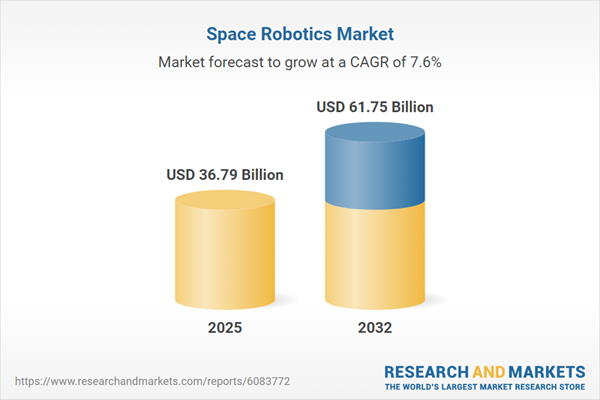Speak directly to the analyst to clarify any post sales queries you may have.
The space robotics market stands at the intersection of advanced engineering and strategic global collaboration, enabling the next era of extraterrestrial operations for leading aerospace organizations, technology providers, and mission-critical stakeholders. As automation reshapes off-world activity, decision-makers are seeking clear insights to navigate emerging opportunities and risks across the full industry ecosystem.
Market Snapshot: A Dynamic Outlook for the Space Robotics Market
The Space Robotics Market grew from USD 34.35 billion in 2024 to USD 36.79 billion in 2025. It is expected to continue growing at a CAGR of 7.60%, reaching USD 61.75 billion by 2032. This vibrant trajectory reflects robust demand as agencies, contractors, and private innovators accelerate development of space-grade autonomous systems, modular robotic assets, and services spanning mission assembly to orbital maintenance. Strategic partnerships and resilient supply chains continue to play a pivotal role in supporting sustained growth and strengthening global competitiveness.
Scope & Segmentation: Mapping Technologies, Applications, and Regional Expansion
This report analyzes the space robotics market across several key dimensions to provide actionable intelligence for stakeholders:
- Product Types: Robotics & Subsystems, Sensors & Autonomous Systems, Software
- Services: De-Orbiting Services, Launch Support, On-Orbit Assembly & Manufacturing, Re-Supply, Satellite Servicing, Surface Mobility
- Type of Robots: Drones, Humanoids, Microbots, Nanobots, Rovers, Satellite Robots
- Application Areas: Autonomous Operations, Resource Extraction, Satellite Assembly, Spacecraft Docking, Communication, Defense & Security, Exploration & Inspection, Planetary Exploration, Space Debris Inspection, Space Station Inspection, Maintenance & Repair, Transportation & Logistics
- End-Users: Commercial Enterprises, Educational Institutions, Government Agencies, Non-profit Organizations, Research Institutions
- Regional Markets: Americas (North America, Latin America), Europe, Middle East & Africa, Asia-Pacific
Market coverage extends from established national programs and leading aerospace firms to disruptive startups and cross-sector partnerships. Segmentation empowers decision-makers to pinpoint high-growth domains and to align innovation, supply, and investment priorities with evolving global demand.
Key Takeaways: Strategic Insights for Industry Leaders
- Adoption of advanced autonomy, AI, and modular architectures is rapidly transforming mission design and operational flexibility for both government and commercial actors.
- Cross-sector collaborations—among prime contractors, startups, and academia—drive innovation cycles, enabling resilient, multi-functional robotic solutions and accelerating technology maturation.
- Public-private partnerships and agile prototyping reduce costs, enhance mission adaptability, and expand access to emerging orbital services and in-situ resource utilization.
- Segment-specific dynamics highlight the value of integrating software and hardware, as well as the need for robust diagnostics and cyber-secure control systems in future missions.
- Regional ecosystems shape competitive differentiation, with key innovation hubs emphasizing agile manufacturing, regulatory clarity, and workforce development in robotics and AI.
Assessing Tariff Impact on Space Robotics Supply Chains
Recent U.S. tariffs on imported space robotics components have introduced new cost structures and sourcing pressures, compelling firms to pivot towards local manufacturing or alternative system architectures. These measures have led to diversification of vendor portfolios, extended lead times, and a reassessment of the balance between domestic capability and imported technology. The resulting supply chain adaptations foster resilience but may entail higher capital commitment and longer timelines to qualification of new production assets. Partnerships with allied international suppliers and adoption of modular, software-upgradable designs help mitigate tariff exposure, supporting continued advancement of mission-critical capabilities.
Methodology & Data Sources
This analysis employs a multi-phase research methodology, beginning with extensive secondary research of technical publications and public filings. In-depth interviews with aerospace executives, engineers, and procurement specialists provide real-world perspectives. Quantitative findings are validated using advanced scenario planning, segmentation matrices, and sensitivity analysis to deliver data-driven insights relevant to strategic planning.
Why This Report Matters
- Enables informed investment and R&D allocation by detailing emerging technologies, applications, and regional trends that will define next-generation capabilities.
- Supports competitive positioning by mapping segmentation, identifying critical supply chain dynamics, and highlighting the converging impact of policy, innovation, and collaboration.
- Guides risk mitigation through actionable recommendations on agile sourcing strategies, regulatory navigation, and securing robust IP and technology lifecycles.
Conclusion
The space robotics market is characterized by agile innovation, cross-sector partnerships, and the integration of autonomy into critical off-world operations. Senior leaders equipped with targeted insights and a segment-driven approach will be prepared to drive growth, navigate policy shifts, and lead in evolving global markets.
Table of Contents
3. Executive Summary
4. Market Overview
7. Cumulative Impact of Artificial Intelligence 2025
Companies Mentioned
The companies profiled in this Space Robotics market report include:- Airbus S.E.
- Astrobotic Technology, Inc.
- Baker Hughes Company
- Boston Dynamics, Inc.
- Canadian Space Agency
- ClearSpace
- DFKI GmbH
- European Space Agency
- Fugro
- GMV Innovating Solutions S.L.
- Honeybee Robotics
- Indian Space Research Organisation
- Ispace Inc.
- ispace,inc.
- Japan Aerospace Exploration Agency
- L3Harris Technologies, Inc.
- Lockheed Martin Corporation
- Maxar Technologies Holdings Inc.
- Metecs, LLC
- Mitsubishi Electric Corporation
- Motiv Space Systems Inc.
- National Aeronautics and Space Administration
- Northrop Grumman Corporation
- Oceaneering International, Inc.
- PIAP Space Sp. z o.o.
- PickNik Inc.
- Redwire Corporation
- Rogue Space Systems Corporation
- Russian Federal Space Agency
- SpaceRobotics.EU
Table Information
| Report Attribute | Details |
|---|---|
| No. of Pages | 180 |
| Published | November 2025 |
| Forecast Period | 2025 - 2032 |
| Estimated Market Value ( USD | $ 36.79 Billion |
| Forecasted Market Value ( USD | $ 61.75 Billion |
| Compound Annual Growth Rate | 7.6% |
| Regions Covered | Global |
| No. of Companies Mentioned | 31 |








